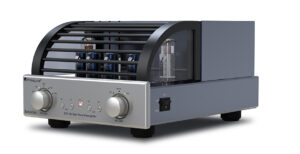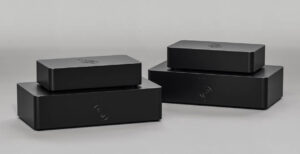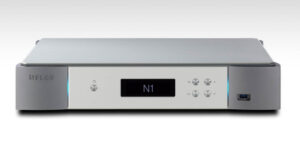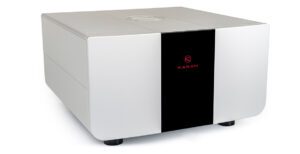
This began as a kind of round two of the CH Precision/Wilson Benesch system we tested back in issue 159. The joy of both main parts of that system is the upgradability they bestow; every part of the CH Precision system can be upgraded through going monophonic and adding power supplies throughout. The WB loudspeakers can be similarly upgraded through the addition of one or more of the company’s own Torus ‘not a subwoofer’ Infrasonic Generators. Where we left the system as a result was kind of half way up the ladder, even if this vantage point put the system well above many of its rivals.
As it happens, though, the upgrade path quickly focussed in on one specific section of the whole system; both because it is fascinating in its own right, and because it shows in microcosm just how significant upgrades to a system can be. There’s also a deeper tale, the telling of which comes a little later. That section to receive ultimate focus is the L1 preamplifier.
By way of revision, the CH Precision L1 is a line-level, dual-monoaural, eight-input, Class A preamplifier that operates under and relies upon a logic control more in line with a computer than a traditional preamp. Far from overcomplicating matters, this is what might best be called ‘necessary complexity’ as it allows the CH Precision L1 a level of flexibility that is unparalleled in audio. And it is that flexibility that is the subject of this exploration… and it is an exploration.
Harking back to that original review, the rest of the system remained more or less extant. The front-end was either a Neodio Origine disc player or a Grand Prix Audio Parabolica turntable, the amplification was all CH Precision (P1 phono stage and M1.1 mono amplifiers), the loudspeakers were from Wilson Benesch (Eminence loudspeakers each with a powered Torus), the cables were all Nordost Odin 2, and the equipment supports were Wilson Benesch’s R1 Racks (for the electronics) and Grand Prix Audio (for the turntable). Roy Gregory reviewed that system originally, he re-received the system after 2019’s Munich High-End, and this was a high time to pay him a visit in his excellent new listening room in France, from which the original review was conducted.

The flexibility is core to CH Precision’s ethos in its own right. In the ten years the company has been in business, not a single product has been ‘left behind’. No product has been discontinued, any products where the original circuitry has either become unavailable (due to components being discontinued) or is too outmoded to be relevant has been upgraded and those upgrades are fully retrofittable. In addition, when it comes to upgrades, there are no ‘side-alleys’; no stepping-stone products that end up being surplus to requirements if and when you move up to the next level (the nearest to a side-alley is the recent integrated amplifier, which doesn’t have a major and obvious upgrade pathway into the pre/power electronics, although you can add in DACs and power amplifiers). So, in the case of the L1 preamplifier, there are options to add power supplies or a second L1 preamp to make it a pure monaural preamp, or even mono preamplifiers each with their own dedicated power supply. This could mean a few steps along the way that might work better or worse than others; what pathway is the right way?
But let’s start with the base L1 preamplifier. It could be easy to get the wrong idea about any product as upgradable as this one and assume all the steps along the way were just hobbled versions of the four-box top of the tree, and that every step just tantalises you to make the next upgrade. In fact, nothing could be further from the truth, as the solo L1 preamplifier already begins as one of the very few truly outstanding preamplifiers you can buy. It has that remarkably stark honesty and clarity of something like a passive preamplifier but with the drive and dynamic weight of a good active preamplifier. It lets the music do the talking, with no noticeable sins of omission or commission, just that sense of realising the almost unattainable goal of a ‘straight wire with gain’ in preamp form. In fact, the L1 is perhaps most surprising when compared to other preamplifiers, because in almost every case you want to say ‘other, lesserpreamplifiers’. The tiny group that can go toe-to-toe with the base L1 are among the best; c-j, Zanden, D’Agostino, Air Tight, Soulution, VTL… that sort of grade. And in most cases, the reason they sound so good is they do so little. Unlike many of the best, the CH Precision concept doesn’t include getting out a crucifix and holy water the moment someone utters the words ‘remote control’.

Also unlike most of these preamplifiers, the L1 can shift up a few gears thanks to upgrade options. The choice then becomes ‘which options?’ The first step gives the listener the choice of either adding a second L1 to make a pure monaural system or keeping the stereo preamplifier as is and adding the X1 power supply. There are those who argue for both, but I’m going with the majority and recommend the stereo+power supply over PSU-less mono version. Physically, the difference is the additional power supply takes over the power feed duties for almost all of the L1 (the existing power supply of the L1 simply feeds the logic circuit). Sonically, it extends the performance of the L1 in terms of solidity and accuracy of sound by no small margin. It essentially takes what the L1 is striving to do and make more of it in almost every respect. By way of contrast, the mono version takes what the L1 is striving to do and makes more of the soundstage alone. This creates something close to an emphasis on the soundstaging properties of the L1; in most other preamplifiers, this would seem like a triviality, but in a preamp as poised as the L1, the mono/no X1 route makes less sense than the L1+X1. That being said, in a system where soundstaging is a key function in and of itself, the paired L1’s might be the better prospect; if, for example, they were being used to control a pair of the best Stax earspeakers and energiser, or systems of that ilk.
The X1 is, in its standard guise, a single-output, ultra-low-noise, ultra-regulated DC power supply designed to drive almost every block in the CH Precision front end and control (except for the T1 clock generator for the digital audio side). As with all CH Precision products, it shares a similar casework, and the inherent modularity – coupled with a pair of really beefy transformers – makes it heavier than many power amplifiers. There is provision for an upgrade card allowing the X1 to drive two separate units, and the nature of the X1 circuit layout means if you have that card in a X1 and it cannot detect a component taking feed from it, the optional board is switched out of circuit.
The next step is the interesting one. At this point, you either have a single L1 preamp and X1 power supply, or a pair of L1 preamps and no power supply. Where next? Logically, it should be an extra box (either an additional L1 in the L1/X1 system, or your first X1 in a L1/L1 system), but I’d argue strongly to just make the next jump to the full quartet, rather than the intermediary that ends with two L1s being driven by a single X1. If you upgrade to two X1s, you don’t lose out here; you simply buy an ‘empty’ X1 and migrate one of the output cards.

In fact, the simplest part of the whole test was the move from two boxes, to three, to four. Because the move to three boxes is not worth the effort, unless it’s a very short jump to four. Let’s face it, three CH preamp boxes works out at £59,800 and four boxes works out at around £69,800. Curiously, if you were talking about the difference between a £7,500 and a £9,000 preamp, the increase in price might be too much to bear, but I suspect if you are already £59,800 deep down the CH preamp rabbit hole, the jump to the full four-box stack is not as unattainable in absolute terms. Another way of saying this is “no one ever saved up for a £43,800 preamp!”
OK, let’s set this in context. The three-box system improves on either version of the two-box preamp. It adds depth to the soundstage of the L1/X1 system and adds some rootedness to the deft touch of the L1/L1. But these are relatively minor improvements, more finessing the icing on the cake, where the full four box stack just adds more cake, gives the recipe to a better baker, and puts thicker icing all over. If you try the three-box, you’ll likely stay with two, but if you hear the four box, there’s no going back.
At this point an already extremely well balanced and poised preamplifier shifts up several gears. That poise becomes laser-guided, extracting every last piece of musical and physical information from the recording, making Joyce DiDonato’s voice on Stella di Napoli [Erato] stand out effortlessly. Her voice – always powerful – is practically weaponised here, and yet not too big or small, just correct. It is also perfectly delineated from the horn player on the Bellini aria from I Capuletti E I Montecchi. But, in fairness, it’s so hard to single out recordings to highlight what’s good or bad about the CH Precision, because it’s all good and none of it is bad.
The last part in this exploration is placement. As discussed previously, the stock system is to use bars and stand-offs that fit into the feet and legs of the CH Precision chassis… but we quickly discounted that. Another way is to use a single stack of L1, X1, L1, X1 on a suitably high-performance equipment stand (such as Wilson Benesch R1s). This works well, but an even better way is to adopt a layout popularised by some Naim users (who, let’s face it, know their way around a power-supply or three). They use what they call a ‘brains stack’ and a ‘brawn stack’, placing the L1/L1 on one table and the X1/X1 on an adjacent table in order to reduce interference from power supply transformers, for example. This proved an exploration worth making, as it lowered the noise floor… slightly. It wasn’t a big change to the performance, and it didn’t transform the performance of the full preamp stack, but it did help make an already almost-silent noise floor move a notch quieter. I’ve tried this on a number of power supplies (not just CH and Naim) and the improvement seems to happen across the board, so it’s a low-impact tweak that’s worth making… or at least experimenting with.

In the process of moving from one box to four, CH Precision’s L1 preamplifier moves from a dual-mono stereo preamp to a full four chassis pure monaural preamp where nothing (even down to the cables) is shared. In the process, it moves from being among the best preamps money can buy to being one of the best preamps ever made, and with no products left behind along the way. I’ve not heard all the very best preamps in the world, but I’ve heard many of them, and this is the best I’ve ever heard to date. We’re still not completely done here; does the P1 phono stage have the same steps up the ladder and is four boxes better than one here too? What about the full digital stack… all nine boxes of it? And then, this year CH Precision announced an even more up-market range – will that take CH to even new levels? Yet more sequels follow.
TECHNICAL SPECIFICATIONS
CH Precision L1 Dual Monoaural Line Preamplifier
- Inputs: 4x XLR, 2x RCA, 2x BNC (double this in dual-mono mode)
- Maximum input level: 16V RMS (XLR), 8V RMS (RCA, BNC)
- Frequency Response: DC-1MHz
- THD+N: < 0.001%, 1kHz, Unity Gain
- S/N ratio: 130dB
- Input impedance: Balanced (XLR) 100kΩ or 600Ω, single-ended (RCA and BNC): 50kΩ or 300Ω
- Dimensions (W×H×D): 44 × 44 × 13.3cm
- Weight: 20kg
- Price: £26,500 per unit / £43,800 as a Mono Pair
CH Precision X1 Power Supply
- Connections: M23 connector for connection to L1, P1, D1, C1, C1 Mono Controller in CH Precision range. Supplied with 2m M23 connector. Optional plug-in module for second M23 connector to run two units
- Dimensions (W×H×D): 44 × 44 × 13.3cm
- Weight: 25kg
- Price: £13,000 per unit / £16,000 with additional regulation board allowing the X1 to power two units
Manufactured by: CH Precision
URL: ch-precision.com
Distributed in the UK by: Singularity Audio
(trading name of Wilson Benesch)
Tel: +44(0)114 442 0129
Tags: FEATURED
By Alan Sircom
More articles from this authorRead Next From Review
See all
PrimaLuna EVO 100 phono preamplifier
- Apr 22, 2024

Reiki Audio SuperSwitch Master Pro + Servant Pro
- Mar 27, 2024

Melco Audio N1-S38 music server
- Mar 27, 2024











